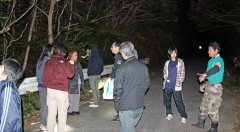Residents patrol Yambaru forest

On February 16, residents patrol along a forest road in Kunigami.
February 24, 2013 Ryukyu Shimpo
In the Yambaru areas of the northern part of Okinawa, local people are going on patrols to protect rare animals and plants. The main purpose of their activities is to prevent poaching and theft of plants, but they also enjoy roaming through the Yambaru forest while on patrol. The patrols are also being carried out in an attempt to reiterate the importance of the Yambaru forest, which is included on the tentative list of nominees for UNESCO World Heritage registration.
The Yambaru Wildlife Conservation Center of the Ministry of the Environment organized this patrol activity in cooperation with the Council for Conservation of the Yambaru Forest and local residents, and has carried out the patrol in Oku, Benoki and Yona in Kunigami, and Takazato in Ogimi. Reiko Takizawa, a native conservation ranger at the center said, “Through the patrols, we want people to be aware of their own community.”
On February 16, ten residents from the Yona district of Kunigami participated in the patrol with Yasuo Yamakawa, the Council for Conservation of the Yambaru Forest vice-chairman and Nozomi Murakami, a photographer from the Shinsei Publishing Company. They listened to an explanation about nature from relevant experts, saw fruit bats and heard the sound of the endangered Ishikawa’s frog. Kunigami Junior High School pupil Anzu Oshiro who participated in the patrol with her mother, said, “I thought that there would be many living creatures out here, so I was very glad that I heard the sound of many of them.”
After the patrol, the participants wrote the names of animals, plants and trash that they saw on the community store board which is used for sharing information on nature.
Mamoru Miyagi, resident of Yona who participated for the third time said, “I have seen someone trying to steal plants. We need to act now in order to protect the Yambaru.”
(English translation by T&CT, Hitomi Shinzato and Mark Ealey)
Previous Article:Community members pray for good harvest at Ueda Ugan
Next Article:[Editorial] Celebrating the date of restoration of Japan’s sovereignty is further humiliation for Okinawa Is Japan really an independent nation?
[Similar Articles]
- Protect the Yambaru Long-Armed Scarab Beetle: In three northern Okinawa villages, 30 people participate in patrol to prevent poaching
- Okinawa Prefecture and the Ministry of the Environment patrol Yambaru forest to stop poaching
- Yambaru kuina rescued from road accident released in forest
- Yambaru National Park: Wild forest area in northern Okinawa designated national park
- A walk through vibrant forest along Arakawa gawa and Fun gawa
 Webcam(Kokusai Street)
Webcam(Kokusai Street)


